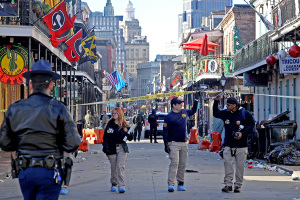The future of our high schoolers is at stake. Let's invest in them

If there ever were a time to volunteer at your local high school, it is now. America has over 15 million high school students who have lived through this COVID pandemic. While we can argue that it has tested us all, it has robbed these students of what former students enjoyed — a time of discovery.
In my experience as a volunteer with teens, you learn when to challenge teens to work harder or when to encourage them in what they are already doing. Usually, students need a little bit of both. But I’ve seen something else lately — students are losing hope. As adults, we know the stress and uncertainty this pandemic has caused, but what about teens? Are we seeing their struggle?
This isn’t about how bad public schools are — I’ve volunteered with schools for most of my adult life, and until you get inside classrooms, talk with teachers and students, you don’t have a full picture. But this much is certain: with over two years of interrupted classroom learning, students need more than just simple encouragement to make progress in their life goals. Graduation is coming quickly. Some of the teens I’ve talked with are more uncertain about the future than just the normal uncertainty of pending adulthood. Some are disinterested in what lies ahead. Some are anxious that things will get worse. Many just aren’t ready to deal with it.
Yes, I empathize with our teachers and the burden they carry. They are being battered and bullied into making sure their students get “caught up”. They are having to communicate through masks and dealing with staff shortages. They are being held accountable for getting their students through this. Some teachers feel like giving up. So do some students.
But we can’t forget that we are the “adults in the room.” We need to recognize that the foundation for these students’ future is usually built over four years of high school. It has been a haphazard construction project at best. We are dealing with teens who have had a fractured high school experience. From distance learning, which was wrought with inconsistencies in style and internet connectivity, to the grading scales that changed to make it easier to pass courses, these teens have received less education. What they have learned are pandemic fears, home-life imbalances, and disconnected friendships because only certain students could be together, in “pods” to limit COVID exposure.
I’ve been able to experience what many families with teens are feeling because my grandson is a high school junior. I’ve sadly watched his disappointment over what he hoped high school would be. For half of his freshman year and all his sophomore year, he utilized a Chromebook and logged in from home for remote classes. After playing basketball from the time he was five, he anticipated being part of his high school team. His freshman basketball season was cut in half, and during his sophomore year he played his heart out with no fans in attendance. He decided to quit basketball this year. It just wasn’t fun anymore. So, he got an after-school job instead.
But after working steadily for a few months, the Omicron variant reared its ugly head. Now he must wait for 2 negative COVID tests after every new COVID exposure before he can return to work. And COVID exposures at school are daily occurrences — at least until this new wave passes. More of his friends are missing school for quarantine purposes as school administrators try to limit exposure. This is “normal” high school.
So, as I talk about the future beyond high school with my grandson, there is zero comparisons with my own high school experience, or even to the experience of those graduating a few years ago. While I can see the impact of COVID — the loss of freedom, the loss of classroom instruction, and the loss of iconic events like school dances and games, what I can’t see is how these events have impacted students. They really don’t have the processing tools to make sense of it. High school should be a time when these processing tools are sharpened for a future that’s just ahead. High school should be a place where students experience life together and have time to look forward to the future.
What do high schoolers think about their future? My grandson and other students I’ve talked with are wary of politics and the division they see. Most are wary of college because they wonder if they are academically equipped to handle the rigor of college courses. Passing tests and required classes is not enough preparation for a future like the one they have. High school should be a training camp for the future. It’s a block of years when students see other students rising to meet a variety of challenges. Before COVID interrupted classrooms everywhere, schools were a place for mentoring and exploring future options. In our school district, we used to take students on college tours together — so they could see and experience what it might be like. We haven’t done that since 2019.
Our current high school students are being given waivers for classes they need to pass but can’t. Some schools are waiving credits needed to graduate, but you can’t waive experiences you should have had, but didn’t.
It’s up to those of us who know these students to come alongside and listen to their stories. Hear their confusion about what it is they are supposed to be ready to do when they graduate. For some students, taking a “gap” year between high school graduation and college might give them opportunities to explore, travel, work, and consider options. For other students, they need to be encouraged to pursue their interests in college or trade school. All of them need to be challenged to work — because part of adulthood is the responsibility of caring for your own needs. But those are the hardest lessons to teach, yet are the most vital to know.
What we can’t afford is to ignore these young people. It may sound cliché to say these students are our future but aren’t they?
Consider volunteering at your local high school. You can start an evening club for juniors and seniors to come, hang out, and talk about their interests. You can volunteer to help with college applications, help prepare students for tests, and just be an adult friend. Here in our district, a man volunteered to start a technology club to explore all that’s happening in the world of computer science and cryptocurrency. In a rural district like ours, this is something we’d never be able to do without his expertise.
Teens are a worthy investment of our time. This is a God-given opportunity to share our love and light with many teens desperate for both.
Karen Farris saw the need to help underserved kids while serving in a youth ministry that gave her the opportunity to visit rural schools on the Olympic Peninsula. She now volunteers her time grant writing to bring resources to kids in need. She also shares stories of faith in action for those needing a dose of hope on her weekly blog, Friday Tidings.www.fridaytidings.com



























